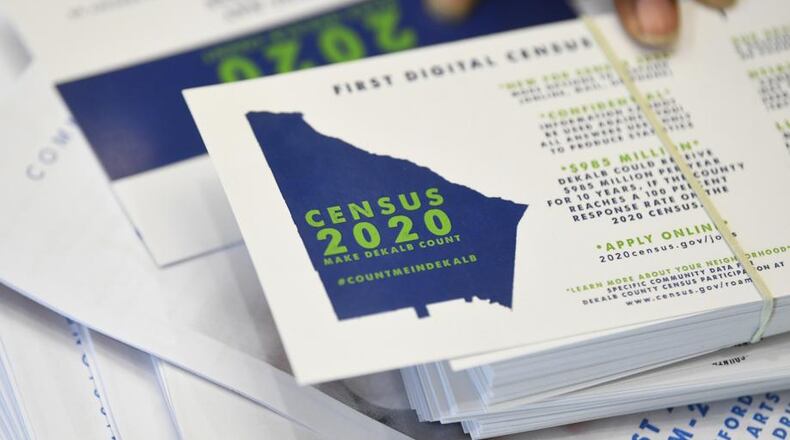The count comes every 10 years, and this one will show how the region changed in the aftermath of the Great Recession and what happened to people displaced by the Memorial Day tornadoes.
And many minority groups are distrustful of giving their information, prompting local leaders, faith communities and businesses to say they will work double-time to get out information proving the census is secure.
“We need to count everyone once and only once— and in the right place,” said Carol Hector-Harris, media specialist for the U.S. Census Bureau - Philadelphia region. “If we miss anyone, we’re missing federal money and we’re missing representation in Congress.”
The federal government distributes about $675 billion annually based on the population of each state, Hector-Harris said.
The Dayton-Montgomery County Complete Count Committee was established in 2018 to stress to residents the importance of completing the census.
Nikol Miller, the chair of the complete count committee, said the group has worked to create a large network of people who can educate city and county residents on the importance of getting an accurate count.
“We’re really trying to meet people where they’re at, whether it be at school, at their church, at the grocery store,” Miller said. “It’s a lot of moving parts.”
Privacy concerns worry some
The Census Bureau is bound by Title 13 of the U.S. Code to keep your information confidential, according to census officials.
After much back-and-forth, no citizenship question will be on the census. The U.S. Supreme Court ruled that question unconstitutional, Hector-Harris said. Still, she said, many minority groups are distrustful of what will be done with information they give.
“The Census Bureau is an organization that turns that information into statistics,” Hector-Harris said. “We don’t share information with the FBI, the CIA or any other government agency.”
Census workers take a lifetime oath of secrecy.
Miller said the local committee has worked with faith leaders and other “local faces” in various ethnic communities to pass along messaging about the census.
“There is distrust in the government, but if information comes to you from someone you trust, like a faith leader, you might be more likely to listen,” Miller said. “These leaders go back to their ethnic enclaves and give the messaging.”
Why a complete count is important
According to a study from the George Washington University, each person not counted in Ohio is a loss of $1,800 per year for the state.
A correct population count is a way of getting back tax dollars that workers pay to the federal government, Hector-Harris said.
State population counts are used to determine how many seats each state gets in the U.S. House of Representatives. Southern states and western states are expected to gain congressional seats after the 2020 Census numbers are finalized, according to census officials. The count also helps draw boundaries for congressional, state and local districts.
“Responding to the census is part of our civic duty,” Hector-Harris said.
MORE: Concerns raised over 2020 census accuracy, funding
Census totals help the federal government determine how much funding a state or local government should get for the next decade. An accurate count ensures funding for programs like Medicaid, highway spending and the SNAP program, formerly food stamps, are equitably distributed.
Problems with under-counting
Children are often under-counted, Hector-Harris said. Minorities, immigrants and renters are also under-counted, she added.
Since the population is only counted every 10 years, it is important that even infants are counted, said Hector-Harris. Children 0 to 5 years old are a critical age to count.
“If we don’t count a 4-year-old in 2020, the next time that kid can be counted is when he is a 14-year-old,” she said. “Hospitals that serve children, schools and other services for children won’t have the correct count.”
This can lead to critical services not having enough funding for the population that would use them. It can also put a strain on existing services in a community.
A third of the federal funding the Greater Dayton Regional Transit Authority (RTA) gets comes from census data, Miller said.
The location of food deserts, several of which exist in Montgomery County, comes from census data.
“People don’t realize all this stuff is based on census data,” Miller said. “Services might not get adequately funded if our community isn’t counted accurately.”
Businesses also determine where to build based off of census data, Hector-Harris said.
“People always moan and groan about businesses or restaurants not coming to their town, but if their town is accurately counted, they might be more likely to draw businesses,” she said. “When a new business comes, that’s jobs and revenue coming to the city.”
The Dayton Unit of the NAACP will host a local discussion about the 2020 Census on Monday.
A panel will discuss the importance of being counted in the census. Miller, Montgomery County Commissioner Judy Dodge, Dayton Daily News Editor Jim Bebbington and Huber Heights City Manager Rob Schommer will be on the panel.
The discussion will start at 6:30 at Roosevelt School, 1923 W. Third St.
What about people displaced by tornadoes?
The devastating Dayton-area Memorial Day tornadoes also pose a challenge to counting residents, because many people have been displaced and their housing and living situations are in flux. Some displaced residents may be hard to locate and may not have long-term living plans.
A new clause in the census says residents displaced by the tornadoes should report where they intend to return, said Stacy Schweikhart, director of strategy and engagement for the Miami Valley Regional Planning Commission (MVRPC).
If a displaced person plans to move back to their address in Trotwood or Harrison Twp., for example, they should count themselves at that Trotwood or Harrison Twp. address in the census.
If they have been displaced and plan to return to Trotwood or Harrison Twp., but not to the exact address, they should count themselves wherever they live on April 1.
“We know because of the timing there are going to be many residents whose property is still not habitable when the census count starts. So we are going to be doing some work with all of the jurisdictions with the census,” Schweikhart said.
And if someone has been displaced from their home because of the tornadoes and doesn’t plan to return to the city they used to live in, then they should also count themselves at the address they’re living at on Census Day.
“Getting back home is the major thing on those people’s minds, not filling out the census, but counting them in the right place is so important,” Hector-Harris said.
What the last census said about the region
Dayton’s population dropped by 15% from the 2000 Census to the 2010 Census.
Some other local communities also lost population in that Census, according to data from MVRPC.
The MVRPC data shows that Harrison Twp.’s population went down 8% from 2000 to 2010. Huber Heights also saw a 3% decrease. The population of Kettering dropped 3%.
Overall, the Miami Valley region saw about a 0.12% decrease in population from the 2000 to the 2010 Census.
Elizabeth Whitaker, a senior planner at MVRPC, said that the 2010 Census came in the middle of the Great Recession, and the economic downturn could have greatly affected the population at the time.
“It will be interesting to see how we bounce back from the 2008 recession,” Whitaker said.
Not all counties lost people, however.
Greene County’s population increased by about 13,000 people, or 9%, from 2000 to 2010. The population of Miami County increased 4% in that time.
Whitaker said counting the population every decade can make data seem outdated. For example, Springboro saw immense growth between the last two censuses, with an increase of 696% in the city’s population.
“Getting a good count is important because we’re stuck with that count for 10 years,” Whitaker said. “There’s no redo.”
How to respond to the census
There are three ways to respond to the U.S. Census. Households can respond online, over the phone or by mail.
This is the first year people can respond to the census online, Miller said.
The Census Bureau will begin mailing detailed information in mid-March on how to respond.
Miller said the census takes about 10 minutes to fill out.
“A correct count impacts the health and future of our community,” Miller said.
JOBS AVAILABLE
The Census Bureau is looking to recruit local people to fill thousands of temporary jobs:
- The salaries range from $18.50 an hour to $20.50 an hour, said Gwen Eberly, economic development and planning manager for Montgomery County.
- There are full-time and part-time positions, so hours can be flexible, said Carol Hector-Harris, media specialist for the U.S. Census Bureau - Philadelphia region.
- To apply, you must be 18 or older and submit to a background check, Hector-Harris said.
- To learn more about job opportunities, Miami Valley residents can go to the Census Bureau's website or call (855) 562-2020.
BY THE NUMBERS
140,000 - the number of people counted in Dayton in 2010
4% - the percent decrease of the population of Montgomery County between 2000 and 2010
$675 billion - the amount of federal funds distributed to states annually based on Census data
About the Author

